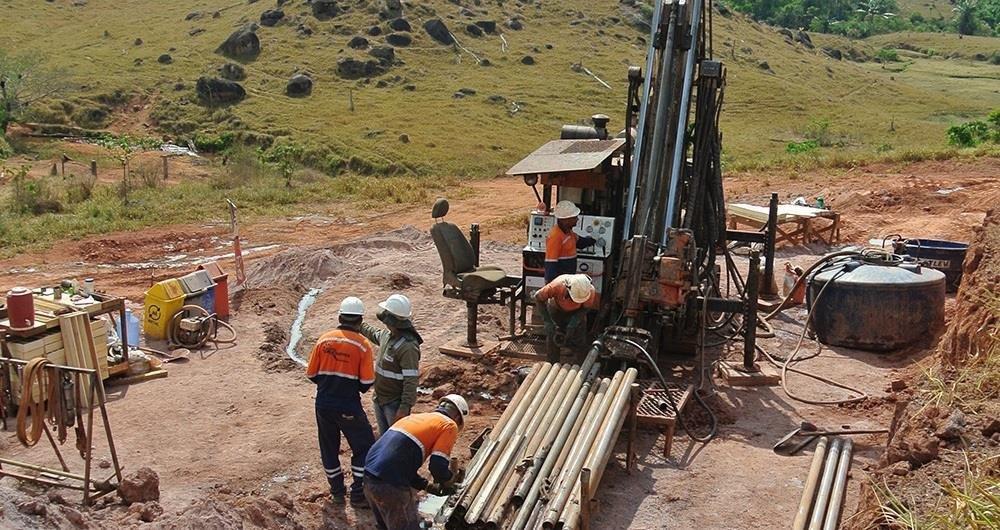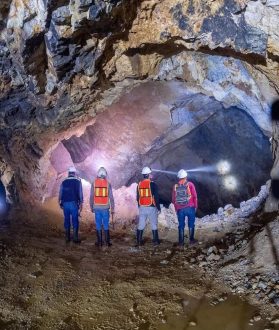
Meridian Mining Continues To Deliver At Cabaçal With More Strong Results
All pictures are company material, unless stated otherwise.
All currencies are in US Dollars, unless stated otherwise.
The company is targeting all three zones with the ongoing drill program, being the Eastern Copper Zone (ECZ), Central Copper Zone (CCZ) and Southern Copper Zone (SCZ), using a combination of twin and infill drilling. Over 4,800m of drilling has been completed to date, meaning almost half of the program is done.
Here is the most recent map with drill collars to date, zoomed in a bit and with drill holes CD-010 to CD-019 circled orange for more clarity: (see attachement)
As can be seen, after the company targeted the more outer regions of the Southern and Eastern Copper Zone with drill holes CD-001 to CD-009, the last two batches with holes CD-010 to CD-019 focused more on zones within the historic workings around the Central Copper Zone. When looking at the map as a non-geologist, it seems as if the sequence of drill holes appears to be somewhat random instead of systematically exploring zones, something I noticed earlier, so I wondered what the overall strategy behind this particular pattern is, if they want to make sure they have some very good twin holes with every batch, mixed with more high risk infill drill holes which could disappoint of course, or following up on local geological concepts, or mixing some exploration of outer limits with infill each time in order to make efficiency for scale and grade as high as possible, or something else. CEO Adrian McArthur answered that the selection of sites drilled represent a combination of twin and infill holes; the twin holes need to span the range of holes drilled over the course of the project history. the pattern is different to what we would see in a newly discovered body of mineralization which would undergo systematic grid spacings. The program also targets certain high-grade Copper zones that were previously unmined, to both the near surface and extensions to the South East and North West.
Since drilling within historic underground workings could pose problems when the drill bit hits underground voids, as drill bits could be lost and holes could have to be terminated then, I wondered if management already encountered more these situations besides the several cases reported like at hole CD-012, and if not, how they manage to work around this, as I am not sure how accurate their underground maps/modelling are of the current situation. McArthur answered the position of the underground room and pillar workings can be seen in plan view in the diagram and is digitized from end-of-mine records. Workings do present a challenge in drilling. When we anticipate voids, we drill vertical holes with larger diameter HQ reducing to NQ diameter, which in good conditions allow us to cross a couple of levels.
It was interesting to read about the deployment of their new deep penetrating EM geophysical equipment, with surveys in progress over VTEM conductors at the Cabaçal West target, followed by surveys at the Cabaçal South conductors, in an attempt to expand the footprint of the known mineralization, well beyond the limits of current underground workings. As per the news release of June 15th:
“Extensions to the mineral system will be surveyed by a combination of EM and IP geophysical surveys in the coming weeks. The Company’s own modern Induced Polarization equipment is in the field targeting the disseminated and more brecciated styles of Cu-Au mineralization; supplementing the Company’s EM equipment that is now surveying and targeting more massive sulphide targets; with first results by late June. First IP and EM results are expected to extend mineralisation out from the mine’s limits and to vector near mine targets, starting with the down plunge Cabaçal West VTEM plates then proceeding to the Eastern-Copper-Zone (“ECZ”) ~1000m south-eastern extension. Once the mine and near-mine upside is defined the geophysics will expand along the 16.0km long Mine Corridor zone.”
The location of the VTEM conductors at the Cabaçal West target are not indicated at the map provided in the news release, so I asked McArthur to indicate them in the map below: (see attachement)
On a sidenote: a recent soil sampling program confirmed lots of promising exploration potential to the north-west, for about a 1,000m additional meters and management currently has one rig allocated to extending the drill program over this corridor.
The collection of white stars at the right (and south-east of the Eastern Copper Zone) indicate the VTEM anomalies which will be followed upon after the Cabaçal West VTEM plates are surveyed. The narrow VTEM plates located to the south are secondary targets, and will be surveyed together with the VTEM plates at the Cabaçal North West target. These VTEM targets are located much deeper than current drilling and historic workings, as can be seen here in this schematic section, the VTEM targets being visualized by reddish rectangles, extending to about 600m depth: (see attachement)
As these targets are located much deeper, I wondered how this could be related to the geology of the existing VMS mineralization of Cabaçal, and what McArthur hopes/expects to find here. With the current open pit concept as a starter pit, any nearby underground mineralization certainly doesn’t need to be the grade a standalone underground operation would need. He stated that: “The company will be targeting the Cabaçal West conductors for massive copper sulphide mineralization. The conductors are distributed along the “mine corridor” position – the stratigraphic horizon which hosts the Cabaçal Cu-Au-Ag deposit and the St Helena Zn-Pb-Ag-Au deposit. The stratigraphic horizon is tilted and thus has potential for discovery of deposits down-dip. The history in analogue VMS camps is that some deposits are discovered at surface, whilst others are present at depth. The belt has a high degree of deformation – with the lower contact of the Cabaçal mineralization pile being a thrust fault. Targets such as Cabaçal West could potentially represent structural offsets to the Cabaçal system itself, or the various VTEM targets may be related to separate hydrothermal centres.”
So far for the more general concepts of mineralization and exploration, let’s have a look at the recent drill results. The absolute highlights of the latest two batches are the following three assays:
- CD-013: 116.5m @ 0.7% CuEq of cumulative Cu-Au-Ag mineralisation from 8.0m; including:
– 94.0m @ 0.7% CuEq from 8.0m; including 8.5m @ 1.9% CuEq from 54.5m;
– 22.5m @ 0.7% CuEq from 110.5m; including 5.6m @ 1.6% CuEq from 119.2m ;
- CD-017: 0m @ 1.0% CuEq from 29.0m, including:
– 9.6m @ 3.3% CuEq from 56.0m;
- CD-019: 110.7m @ 0.6% CuEq from 12.0m, including:
– 62.5m @ 0.6% CuEq from 12.0m, including:
– 2.5m @ 3.1% CuEq from 20.7m;
– 2.2m @ 3.5% CuEq from 53.5m;
– 17.2m @ 1.2% CuEq from 130m;
I especially like the near surface character of these long intercepts, resulting in a hypothetical strip ratio of 0.07-0.63 : 1 at these particular collars, which of course isn’t the case at all mineralized intercepts, as the envelope gently dips to the south-west: (see attachement)
Notwithstanding this, an average strip ratio of close to 1-1.5 : 1 seems to be achievable here, just like an average CuEq grade of about 1%, and this could make this deposit extremely economic. For reference, an open pit gold deposit of 1g/t and a strip ratio of 4:1 is already economic (after-tax IRR >20%) at US$1300/oz Au, with a gross metal value of just over US$40/t. At a current copper price of US$4.28/lb Cu, the gross metal value of Cabaçal would be US$94/t at a 1% CuEq grade, so at a much lower estimated strip ratio than 4 : 1 the economics will certainly be impressive. It is a bit early to go after economics yet, but rest assured, as soon as management seems to get a grip on the size potential, I will set up a peer comparison and derive hypothetical economics for Cabaçal from there.
Back to the drill results. Here are the tables with the complete results, with the highlights in green: (see attachement)
Holes CD-010 and CD-011 are assay results from the north-western limit of the CCZ mined area, highlighted the presence of shallow layers of open Cu-Au mineralisation providing future drill targets extending to the northwest of the historical workings. As CD-011 didn’t return much economic mineralization, it might indicate the northern end of the Central Copper Zone. CD-010 is much more interesting, with all the stacked layers, solid grade and near surface it could provide the potential for extension along strike.
CD-012 was designed to twin a zone of Cu-Au mineralisation intercepted by BP Mineral’s DDH JUSPD076 that returned (pre-mining) 42.2m @ 0.9% Cu, 0.6g/t Au & 3.2 g/t Ag from 59.8m. The CD-012 intercept of the same zone returned a favourable 40.0m @ 0.6% Cu, 0.6g/t Au, 2.2g/t Ag, 0.1% Zn from 59.8m. This excludes the mineralised zone within the 4.0m mining void that was intercepted by CD-012. According to McArthur, accounting for the mining void, the hole shows a good correlation with the historical results.
CD-013 targeted the Eastern Copper Zone and intercepted extensive mineralisation starting at 8.0m. The hole confirms that thick high-grade shallow mineralization remains after the selective but short-lived mining in the 1980’s and 1990’s by BP Minerals and Rio Tinto. The results highlight the potential of the ECZ, for infill resource definition drilling. As CD-013 is located at the edge of historic workings, and starting close to surface, with the mineralized envelope trending upwards to surface, I wondered what the results of historic hole JUSPD150 were: (see attachement)
Continuing at this train of thought, I wondered if management isn’t designing a fence, off-setting the edge of the historic workings by for example 50 to 100m. I have drawn a light blue line in the above map with the drill collars as an example for such a fence, consisting of say 3-4 holes. McArthur answered the Eastern Copper Zone corridor will be targeted by fences of drill holes as part of the ongoing program. The corridor projecting through the decline position is comparatively sparsely drilled – being shallower and more copper-dominant was not a significant focus in the BP/RTZ programs; so there is a need to infill this as part of the resource definition program.
CD-014 was designed to more or less twin JUSPD048 that returned 20.1m @ 0.3% Cu, 0.0g/t Au from 22m, 17.6m @ 0.3% Cu, 0.1g/t Au from 47.4m; 40.9m @ 0.7% Cu, 0.6g/t Au from 68.4m). CD-014 returned comparable results to the upper copper zones of JUSPD048, of 26.4m @ 0.3% Cu, 0.2g/t Au, 0.4g/t Ag from 20m, and 20.5m @ 0.6% Cu, 0.3g/t Au, 0.4g/t Ag from 54m). CD-014 struck a void from 75.1m-78.5m; and was terminated without fully traversing the lower results of JUSPD048. As the void was located above the lower results of JUSPD048, I wondered what those lower results were. McArthur stated the hole terminated without transecting the full interval of 40.9m @ 0.7% Cu, 0.6g/t Au from 68.4m noted above in JUSPD048. Below the void, we would have anticipated ~ 30.3m @ 0.8% Cu, 0.7g/t Au as part of this historical JUSPD048 intersection
CD-015 was designed to twin JUSPD068, which historically returned 42.7m @ 0.7% Cu, 0.5% Au from 43.8m in the CCZ. CD015 traversed a mining void between 52.7 – 56.4m, and assays returned 20m @ 0.2% Cu, 0.1g;t Au, 0.7g/t Ag from 12m, and an aggregate 46m @ 0.4% Cu, 0.6g/t Au, 1.2g/t Ag from 37m, comprising 15.7m @ 0.4% Cu, 0.1g/t Au, 0.7g/t Ag 37m above the void, and 30.3m @ 0.5% Cu, 0.9g/t Au, 1.5g/t Ag from 56.4m. The lower zone included higher grade intervals of 3.8m @ 1.3% Cu, 0.4g/t Au, 1.7g/t Ag from 43m, and 6.1m @ 0.4% Cu, 1.0g/t Au, 1.0g/t Ag from 67.2m, 4.5m @ 1% Cu, 3.3g/t Au, 4.6g/t Ag from 77.9m. The hole terminated mineralization due to the drilling conditions (the holes was not advancing in mildly fractured ground; not assisted by due in the rod string from the void above].
CD-016 was designed to twin JUSPD280 , which historically returned 8.7m @ 0.3% Cu, 0.4g/t Au from 29m, 11.7m @ 1.3% Cu , 0.9g/t Au from 50m, and the lower limit of sampling terminating in disseminated copper mineralization at 75.2m. CD-016 traversed a mining void between 85.2 – 86.2m but the hole terminated at 87.1m in fractured ground marginal to the void, and assays returned results included 14m @ 0.3% Cu, 0.7g/t Ag from 20m, 26m @ 0.3% Cu, 0.3g/t Au, 1.4g/t Ag from 42.5m.
CD-017 was designed to twin JUSPD265 that returned 23.2m @ 0.8% Cu, 0.4g/t Au, 3.8g/t Ag from 44.6m (upper limit of sampling) being collared 4.6m from the historical collar. CD-017 returned 46m @ 0.8% Cu, 0.3g/t Au, 3.4g/t Ag from 29.0m, including a higher grade interval of 9.6m @ 2.6% Cu, 0.9g/t Au, 12.2g/t Ag, 0.1% Zn from 56m. McArthur told me the positive difference between the two intersections was simply that the JUSPD265 had not been fully sampled, reflecting the historic lack of interest in the broader disseminated mineralization halo – requiring careful scrutiny of the database to identify other areas where mineralization may be under-represented as we move towards an initial resource calculation.
CD-018 was designed to twin BP’s JUSPD301 that returned 29.0m @ 1.8% Cu, 1.0g/t Au, 8.8g/t Ag from 36.0m. CD-018 returned 14.2m @ 0.3% Cu, 0.1g/t Au, 0.8g/t Ag from 9m (an interval incompletely sampled in JUSPD301, and 12.4m @ 0.3% Cu, 0.3g/t Au, 0.7g/t Ag from 33m. CD-018 encountered a void from 45.4 to 52.6m and was terminated without replicating the lower results of JUSPD301. This was one of the few disappointing results to me, considering the difference. McArthur explained that the higher grade sector of JUSPD301 was located in the lower sector of the drill hole, with the higher grade stringer and breccia sulphide mineralization located in the lowest parts of the pile. The rock mass in some cases around historical mining cavities can be fractured by the original blasting, and inevitably some holes will not be able to cross the full sequence. We will have sufficient holes in the full program nonetheless to characterize the sequence.
CD-019 was designed to infill the ECZ and its aggregated Cu-Au mineralisation returned 110.7m @ 0.64% CuEq of disseminated, stringer and breccia sulphide mineralization. Comprised of 62.5m @ 0.5% Cu, 0.1g/t Au, 0.8g/t Ag from 12m, 31.0m @ 0.2% Cu, 0.3g/t Au, 0.1g/t Ag from 84.0m, and 17.2m @ 0.8% Cu, 0.4g/t Au, 3.9g/t Ag from 130m. CD-019 terminated ~72m SE of CD-013 at a depth of 174.1m and results are consistent down dip extension to the CD-013 results. As CD-019 resembles the very long mineralized intercept of CD-013, it is clear to me these two could be connected, and continue along strike of the nearby historic workings, but also parallel to these workings as discussed earlier. Management sees scope for some additional infill in this and other areas of the Eastern Copper Zone, which is less densely drilled than other sectors of the deposit.
The treasury holds approximately C$5M nowadays, also due to ongoing warrant conversions. On June 3th, the company reported C$2.73M from warrant conversions, and according to Executive Chairman Gilbert Clark, the vast majority of these exercised warrants are in safe hands.
As a reminder, the current drilling is part of the Cabaçal Central 60-70 hole drill program for 8,000m, of which 30 holes are twinning holes, in order to verify the 21.7Mt historic resource estimate. Another 2,000m is also budgeted to confirm the already defined near-mine and regional targets of the VMS camp. A third drill rig is operational now, increasing batch sizes but also turnaround times for assaying.
Conclusion
Drilling at Cabaçal keeps returning pretty economical results, now also with local intercepts much longer than anticipated (CD-013 and CD-019). It seems the infill program is proceeding as planned, and the 21.7Mt historic estimate is becoming a reality to say the least. With the current results, I don’t rule out a 25-30Mt resource, and I am looking forward to the potential new targets the VTEM surveys might generate. And these targets are only close by, there are also large VTEM conductive plates further away, indicating even more potential. It is still early days at Cabaçal for Meridian, but already very impressive. And again, I’m looking forward to start estimating economics, when management has developed a grip on eventual size of this already substantial VMS deposit.
I hope you will find this article interesting and useful and will have further interest in my upcoming articles on mining. To never miss a thing, please subscribe to my free newsletter, in order to get an email notice of my new articles soon after they are published.
Disclaimer:
The author is not a registered investment advisor and has a long position in this stock. Meridian Mining is a sponsoring company. All facts are to be checked by the reader. For more information go to www.meridianmining.co and read the company’s profile and official documents on www.sedar.com, also for important risk disclosures. This article is provided for information purposes only and is not intended to be investment advice of any kind, and all readers are encouraged to do their own due diligence and talk to their own licensed investment advisors prior to making any investment decisions.
Swiss Resource Capital AG
Poststrasse 1
CH9100 Herisau
Telefon: +41 (71) 354-8501
Telefax: +41 (71) 560-4271
http://www.resource-capital.ch
CEO
Telefon: +41 (71) 3548501
E-Mail: js@resource-capital.ch
![]()





